TAMIL culture:
the Heart of Tamil National Consciousness Kolam: Symmetry
in Threshold Design in Tamil Nadu |
Courtesy - Manorama Talaiver
April 25, 1995
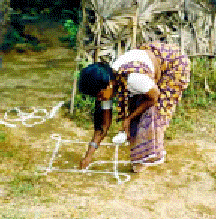 What is threshold design? What is threshold design?
When I was a little girl, my aunt used to get up early in the morning. She would have a shower and then created a symmetrical pattern in the front yard, after cleaning and sprinkling water. Some women in Madras still create these designs. I must admit that I had to drive ten miles from downtown before I found a row of houses with the threshold design. These patterns are normally called "Kolum." O sounds like Oh. U sounds like bun. Kohlum. When the symmetrical pattern is decorated in colors using colored sand or flower, then it is called rangoli. The design or pattern is not symmetrical sometimes, but it is just a continuous line that curves around to make a beautiful border or design at the Center of the yard. . The threshold desing is compared to African sand drawings. These patterns or designs were created in the olden days (according to Tamil literature) using rice flour. Holding a handful of flour in their right hand, the woman will uniformly drop the flour to make a line through her thumb and pointer and keep on moving her hands to make the curve or the dots. Nowadays, women use powder made out of stone. (Stone is crushed and sold commercially). The patterns are very complicated and huge during festival months. The temples will have complex patterns that will cover thousands of square feet. Sometimes, several women together will create one large design. As a child, I have always wondered at the complexity of the pattern and the creativity of the women. The pattern normally starts with putting the dots as follows: . . . . . . . . . . . . . . . . . . . . . . . . This is a very simple design. You start with seven dots in the middle and you skip two to count down. Then, you will use your creativity to circle around the dots (in most cases) or connect the dots (rarely). When a mother is creating this design, a girl tends to watch this from the time she is a baby. My thesis is number concept comes very naturally to girls by observing. When the girl grows up, girls have competitions on who can create a complex pattern and with maximum number of points. Skip count, multiplication, geometric design, function concept and concept of closed curves - all of these can be introduced in math classrooms using the threshold. Based on the concept of Kolum, I will be providing lessons here that can be used in math classrooms. A multicultural Mathematics lesson for Elementary Grades Objectives: 1. To discuss the life of a little third grader in the morning while she watches her mom doing the symmetrical design.
2. To draw a simple symmetrical design as given in this page.
3, To extend this design to a larger number of points.
4. To create other designs for odd number of points.
5. To explore the design differences that can affect symmetry with the use of odd and even number of points.
Materials needed: pencil, paper, crayon, (if you are bold, try rice flour in the kitchen floor) Procedure.
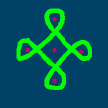
Look at the picture. My first design was drawn using 3, 1 points. 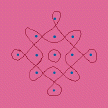
My second design was drawn using 5,3,1 points. 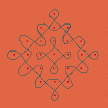
My third design was done with 7,5,3,1. Practice the symmetrical design. Extend the design to 9 points. Questions: How can you extend this further? When you create the design for larger number of points, what can you infer from the patterns? Extension: The next pattern is called Brahma's knot. This design is more complicated to draw. 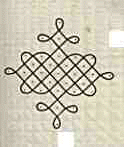
This is the first level of Brahma's knot Can you draw this on a sheet of paper? This is the second level of Brahma's' knot 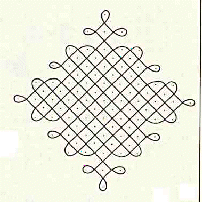
Can you try the second level? Now a challenge What is the next level of Brahma's knot? Can you draw the design and fax it to me? My fax number is 804-343-6529. More pictures from India (March 17, 1995) 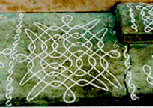
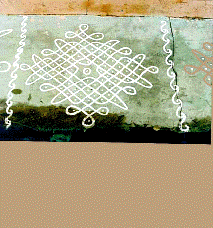
These were some designs on the pavement in front of a house. These are permanent. These were not created with flour but with paint. Slowly the tradition of creating threshold design seems to disappear. After five days of my travel in South India, I found this woman creating the threshold design in front of her hut early morning. I hope this tradition that I love and appreciate continues for ever! I found a few houses with permanent designs in the cities. This means that the women do not create the designs every day. They use white paint to create permanent designs. Something to think about! I was surprised to hear about gender differences in mathematics achievement when I first arrived in the United States. In India, gender differences and related discussions exist about career choices. Female children are normally advised to become teachers, bank tellers, or even bank officers. However, this is not true today. I have never heard a mother telling a girl, "Oh well, you are a girl. You cannot do math." Or I have never heard a teacher talking about gender differences in mathematics achievement. In my school days, girls scored better in all classes than boys. The names of the top five scorers were listed on the blackboard in my classroom every month. When I was a student, two or three of my girl friends including myself were always listed among the top five in math classes. My conviction is that number concepts come naturally to girls in South India. I have no research to support this statement. However, I can argue that the girls watch the mothers create the threshold design in the front yard or in the kitchen. These designs involve numbering, skip counting, symmetry and so on. Is it possible for me to say then that arithmetic or logic is part of a girl's life in India? |